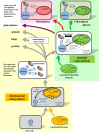Retrograde signals from endosymbiotic organelles: a common control principle in eukaryotic cells
- PMID: 32362267
- PMCID: PMC7209961
- DOI: 10.1098/rstb.2019.0396
Retrograde signals from endosymbiotic organelles: a common control principle in eukaryotic cells
Abstract
Endosymbiotic organelles of eukaryotic cells, the plastids, including chloroplasts and mitochondria, are highly integrated into cellular signalling networks. In both heterotrophic and autotrophic organisms, plastids and/or mitochondria require extensive organelle-to-nucleus communication in order to establish a coordinated expression of their own genomes with the nuclear genome, which encodes the majority of the components of these organelles. This goal is achieved by the use of a variety of signals that inform the cell nucleus about the number and developmental status of the organelles and their reaction to changing external environments. Such signals have been identified in both photosynthetic and non-photosynthetic eukaryotes (known as retrograde signalling and retrograde response, respectively) and, therefore, appear to be universal mechanisms acting in eukaryotes of all kingdoms. In particular, chloroplasts and mitochondria both harbour crucial redox reactions that are the basis of eukaryotic life and are, therefore, especially susceptible to stress from the environment, which they signal to the rest of the cell. These signals are crucial for cell survival, lifespan and environmental adjustment, and regulate quality control and targeted degradation of dysfunctional organelles, metabolic adjustments, and developmental signalling, as well as induction of apoptosis. The functional similarities between retrograde signalling pathways in autotrophic and non-autotrophic organisms are striking, suggesting the existence of common principles in signalling mechanisms or similarities in their evolution. Here, we provide a survey for the newcomers to this field of research and discuss the importance of retrograde signalling in the context of eukaryotic evolution. Furthermore, we discuss commonalities and differences in retrograde signalling mechanisms and propose retrograde signalling as a general signalling mechanism in eukaryotic cells that will be also of interest for the specialist. This article is part of the theme issue 'Retrograde signalling from endosymbiotic organelles'.
Keywords: chloroplasts; intracellular communication; metabolites; mitochondria; plastids; signalling.
Conflict of interest statement
We declare we have no competing interests.
Figures


Similar articles
-
Linking mitochondrial and chloroplast retrograde signalling in plants.Philos Trans R Soc Lond B Biol Sci. 2020 Jun 22;375(1801):20190410. doi: 10.1098/rstb.2019.0410. Epub 2020 May 4. Philos Trans R Soc Lond B Biol Sci. 2020. PMID: 32362265 Free PMC article. Review.
-
The cellular machineries responsible for the division of endosymbiotic organelles.J Plant Res. 2018 Sep;131(5):727-734. doi: 10.1007/s10265-018-1050-9. Epub 2018 Jun 12. J Plant Res. 2018. PMID: 29948488 Free PMC article. Review.
-
Endosymbiotic origin and differential loss of eukaryotic genes.Nature. 2015 Aug 27;524(7566):427-32. doi: 10.1038/nature14963. Epub 2015 Aug 19. Nature. 2015. PMID: 26287458
-
Coordination of gene expression between organellar and nuclear genomes.Nat Rev Genet. 2008 May;9(5):383-95. doi: 10.1038/nrg2348. Nat Rev Genet. 2008. PMID: 18368053 Free PMC article. Review.
-
Genome communication in plants mediated by organelle-n-ucleus-located proteins.Philos Trans R Soc Lond B Biol Sci. 2020 Jun 22;375(1801):20190397. doi: 10.1098/rstb.2019.0397. Epub 2020 May 4. Philos Trans R Soc Lond B Biol Sci. 2020. PMID: 32362260 Free PMC article. Review.
Cited by
-
Redox regulation, thioredoxins, and glutaredoxins in retrograde signalling and gene transcription.J Exp Bot. 2023 Oct 13;74(19):5955-5969. doi: 10.1093/jxb/erad270. J Exp Bot. 2023. PMID: 37453076 Free PMC article. Review.
-
Oxylipins in plastidial retrograde signaling.Redox Biol. 2020 Oct;37:101717. doi: 10.1016/j.redox.2020.101717. Epub 2020 Sep 11. Redox Biol. 2020. PMID: 32979794 Free PMC article. Review.
-
Mitochondrial retrograde signaling through UCP1-mediated inhibition of the plant oxygen-sensing pathway.Curr Biol. 2022 Mar 28;32(6):1403-1411.e4. doi: 10.1016/j.cub.2022.01.037. Epub 2022 Feb 2. Curr Biol. 2022. PMID: 35114096 Free PMC article.
-
NPR1 Translocation from Chloroplast to Nucleus Activates Plant Tolerance to Salt Stress.Antioxidants (Basel). 2023 May 18;12(5):1118. doi: 10.3390/antiox12051118. Antioxidants (Basel). 2023. PMID: 37237984 Free PMC article.
-
Overexpression of RPOTmp Being Targeted to Either Mitochondria or Chloroplasts in Arabidopsis Leads to Overall Transcriptome Changes and Faster Growth.Int J Mol Sci. 2024 Jul 26;25(15):8164. doi: 10.3390/ijms25158164. Int J Mol Sci. 2024. PMID: 39125738 Free PMC article.
References
Publication types
MeSH terms
LinkOut - more resources
Full Text Sources

